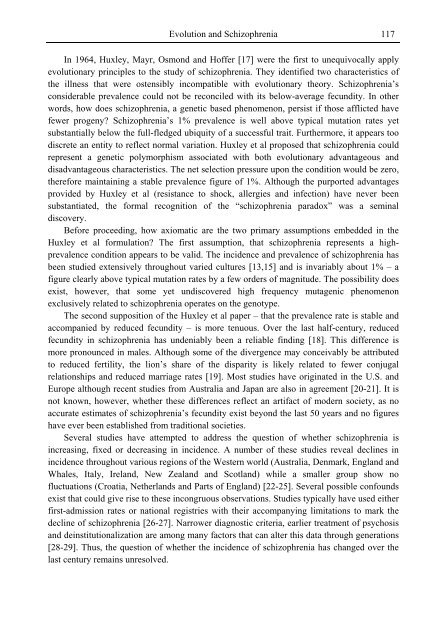Schizophrenia Research Trends
Schizophrenia Research Trends
Schizophrenia Research Trends
- No tags were found...
Create successful ePaper yourself
Turn your PDF publications into a flip-book with our unique Google optimized e-Paper software.
Evolution and <strong>Schizophrenia</strong> 117In 1964, Huxley, Mayr, Osmond and Hoffer [17] were the first to unequivocally applyevolutionary principles to the study of schizophrenia. They identified two characteristics ofthe illness that were ostensibly incompatible with evolutionary theory. <strong>Schizophrenia</strong>’sconsiderable prevalence could not be reconciled with its below-average fecundity. In otherwords, how does schizophrenia, a genetic based phenomenon, persist if those afflicted havefewer progeny? <strong>Schizophrenia</strong>’s 1% prevalence is well above typical mutation rates yetsubstantially below the full-fledged ubiquity of a successful trait. Furthermore, it appears toodiscrete an entity to reflect normal variation. Huxley et al proposed that schizophrenia couldrepresent a genetic polymorphism associated with both evolutionary advantageous anddisadvantageous characteristics. The net selection pressure upon the condition would be zero,therefore maintaining a stable prevalence figure of 1%. Although the purported advantagesprovided by Huxley et al (resistance to shock, allergies and infection) have never beensubstantiated, the formal recognition of the “schizophrenia paradox” was a seminaldiscovery.Before proceeding, how axiomatic are the two primary assumptions embedded in theHuxley et al formulation? The first assumption, that schizophrenia represents a highprevalencecondition appears to be valid. The incidence and prevalence of schizophrenia hasbeen studied extensively throughout varied cultures [13,15] and is invariably about 1% – afigure clearly above typical mutation rates by a few orders of magnitude. The possibility doesexist, however, that some yet undiscovered high frequency mutagenic phenomenonexclusively related to schizophrenia operates on the genotype.The second supposition of the Huxley et al paper – that the prevalence rate is stable andaccompanied by reduced fecundity – is more tenuous. Over the last half-century, reducedfecundity in schizophrenia has undeniably been a reliable finding [18]. This difference ismore pronounced in males. Although some of the divergence may conceivably be attributedto reduced fertility, the lion’s share of the disparity is likely related to fewer conjugalrelationships and reduced marriage rates [19]. Most studies have originated in the U.S. andEurope although recent studies from Australia and Japan are also in agreement [20-21]. It isnot known, however, whether these differences reflect an artifact of modern society, as noaccurate estimates of schizophrenia’s fecundity exist beyond the last 50 years and no figureshave ever been established from traditional societies.Several studies have attempted to address the question of whether schizophrenia isincreasing, fixed or decreasing in incidence. A number of these studies reveal declines inincidence throughout various regions of the Western world (Australia, Denmark, England andWhales, Italy, Ireland, New Zealand and Scotland) while a smaller group show nofluctuations (Croatia, Netherlands and Parts of England) [22-25]. Several possible confoundsexist that could give rise to these incongruous observations. Studies typically have used eitherfirst-admission rates or national registries with their accompanying limitations to mark thedecline of schizophrenia [26-27]. Narrower diagnostic criteria, earlier treatment of psychosisand deinstitutionalization are among many factors that can alter this data through generations[28-29]. Thus, the question of whether the incidence of schizophrenia has changed over thelast century remains unresolved.
















